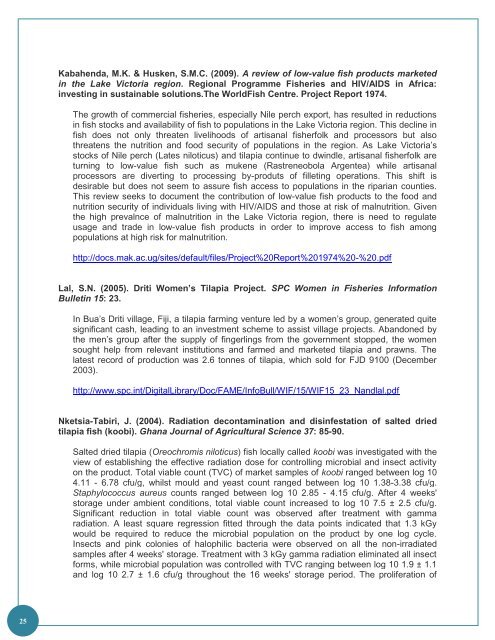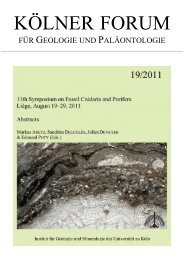Download (989Kb) - USP Electronic Research Repository - The ...
Download (989Kb) - USP Electronic Research Repository - The ...
Download (989Kb) - USP Electronic Research Repository - The ...
Create successful ePaper yourself
Turn your PDF publications into a flip-book with our unique Google optimized e-Paper software.
25<br />
Kabahenda, M.K. & Husken, S.M.C. (2009). A review of low-value fish products marketed<br />
in the Lake Victoria region. Regional Programme Fisheries and HIV/AIDS in Africa:<br />
investing in sustainable solutions.<strong>The</strong> WorldFish Centre. Project Report 1974.<br />
<strong>The</strong> growth of commercial fisheries, especially Nile perch export, has resulted in reductions<br />
in fish stocks and availability of fish to populations in the Lake Victoria region. This decline in<br />
fish does not only threaten livelihoods of artisanal fisherfolk and processors but also<br />
threatens the nutrition and food security of populations in the region. As Lake Victoria‟s<br />
stocks of Nile perch (Lates niloticus) and tilapia continue to dwindle, artisanal fisherfolk are<br />
turning to low-value fish such as mukene (Rastreneobola Argentea) while artisanal<br />
processors are diverting to processing by-produts of filleting operations. This shift is<br />
desirable but does not seem to assure fish access to populations in the riparian counties.<br />
This review seeks to document the contribution of low-value fish products to the food and<br />
nutrition security of individuals living with HIV/AIDS and those at risk of malnutrition. Given<br />
the high prevalnce of malnutrition in the Lake Victoria region, there is need to regulate<br />
usage and trade in low-value fish products in order to improve access to fish among<br />
populations at high risk for malnutrition.<br />
http://docs.mak.ac.ug/sites/default/files/Project%20Report%201974%20-%20.pdf<br />
Lal, S.N. (2005). Driti Women’s Tilapia Project. SPC Women in Fisheries Information<br />
Bulletin 15: 23.<br />
In Bua‟s Driti village, Fiji, a tilapia farming venture led by a women‟s group, generated quite<br />
significant cash, leading to an investment scheme to assist village projects. Abandoned by<br />
the men‟s group after the supply of fingerlings from the government stopped, the women<br />
sought help from relevant institutions and farmed and marketed tilapia and prawns. <strong>The</strong><br />
latest record of production was 2.6 tonnes of tilapia, which sold for FJD 9100 (December<br />
2003).<br />
http://www.spc.int/DigitalLibrary/Doc/FAME/InfoBull/WIF/15/WIF15_23_Nandlal.pdf<br />
Nketsia-Tabiri, J. (2004). Radiation decontamination and disinfestation of salted dried<br />
tilapia fish (koobi). Ghana Journal of Agricultural Science 37: 85-90.<br />
Salted dried tilapia (Oreochromis niloticus) fish locally called koobi was investigated with the<br />
view of establishing the effective radiation dose for controlling microbial and insect activity<br />
on the product. Total viable count (TVC) of market samples of koobi ranged between log 10<br />
4.11 - 6.78 cfu/g, whilst mould and yeast count ranged between log 10 1.38-3.38 cfu/g.<br />
Staphylococcus aureus counts ranged between log 10 2.85 - 4.15 cfu/g. After 4 weeks'<br />
storage under ambient conditions, total viable count increased to log 10 7.5 ± 2.5 cfu/g.<br />
Significant reduction in total viable count was observed after treatment with gamma<br />
radiation. A least square regression fitted through the data points indicated that 1.3 kGy<br />
would be required to reduce the microbial population on the product by one log cycle.<br />
Insects and pink colonies of halophilic bacteria were observed on all the non-irradiated<br />
samples after 4 weeks' storage. Treatment with 3 kGy gamma radiation eliminated all insect<br />
forms, while microbial population was controlled with TVC ranging between log 10 1.9 ± 1.1<br />
and log 10 2.7 ± 1.6 cfu/g throughout the 16 weeks' storage period. <strong>The</strong> proliferation of
















